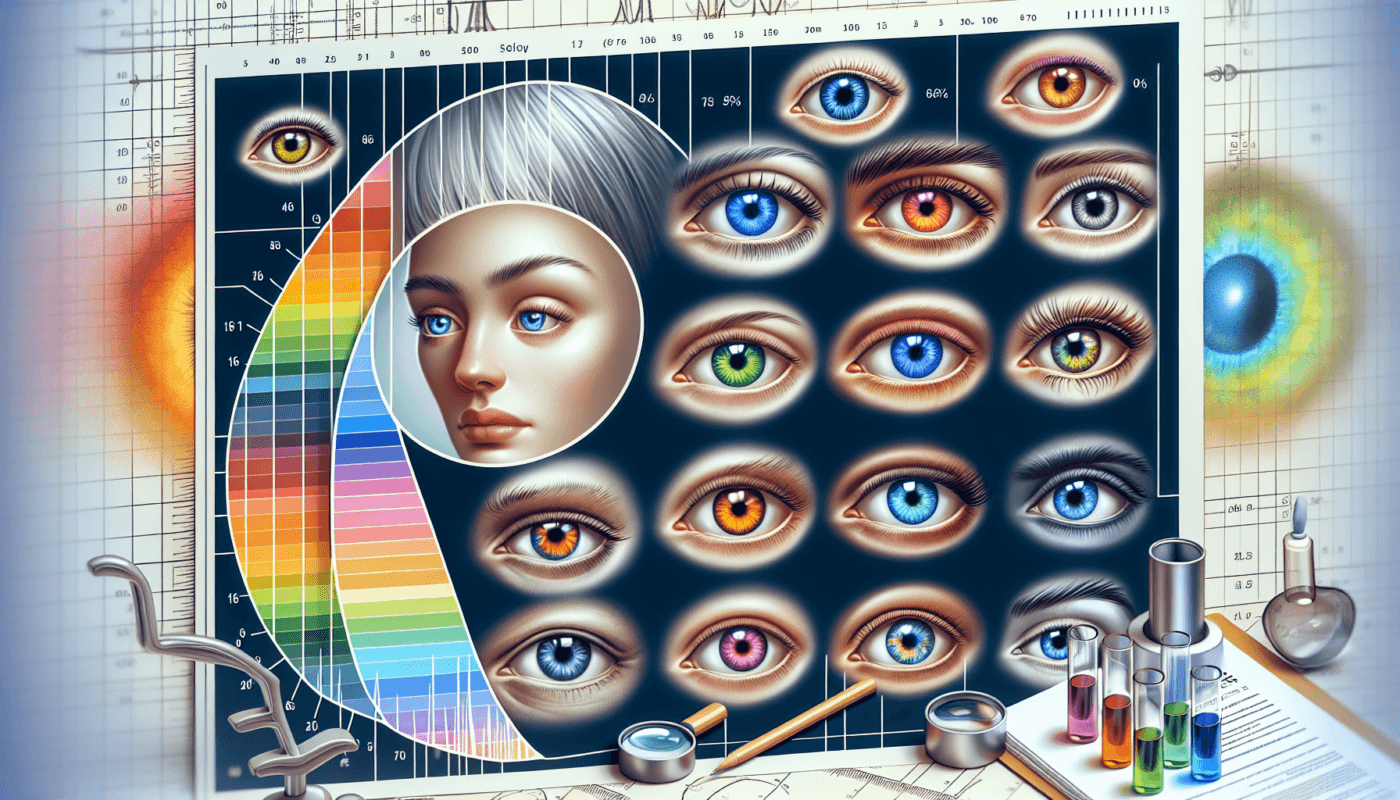
Table of content
Among the spectrum of eye colors found in humans, green stands out as the rarest, adorning only about 2% of the global population [1] [2] [5] [7] [8]. Not far behind in its rarity is the gray eye color, which is observed in less than 1% of people worldwide, placing it among the most unique eye colors alongside amber eyes, blue eyes, and red eyes [1] [7].
This article embarks on an explorative journey into the intriguing world of eye colors, shedding light on the rarity and diversity of shades like eye colors green and others. As we navigate through the sections, we will delve deeper into understanding the genetic and environmental factors contributing to this fascinating aspect of human diversity.
Understanding Eye Color
Eye color in humans is a fascinating genetic trait, governed by a complex interplay of multiple genes, with melanin production playing a central role. Understanding the genetic underpinnings of eye color not only unravels the beauty of human diversity but also provides insights into how genetic variations manifest in physical traits.
- Genetic Foundations of Eye Color:
- The primary determinant of eye color is the OCA2 gene, responsible for melanin production [1][4][5][6][8][9].
- Melanin’s presence in the iris, ranging from high to low, dictates the spectrum of eye colors from brown to blue [1][6][9].
- Beyond OCA2, other genes such as HERC2, ASIP, IRF4, SLC24A4, and more, contribute to eye color variation, highlighting the trait’s genetic complexity [4][5][6][8][9].
- Melanin and Eye Color Variations:
- Brown eyes result from high melanin levels, serving as a protective mechanism against UV light [2][6][9].
- Blue eyes, conversely, exhibit minimal melanin. This scarcity is linked to a genetic mutation in the OCA2 gene [4][6][9].
- Green eyes, a rarer hue, emerge from a unique balance of low black melanin and higher yellow melanin levels [2].
- Inheritance Patterns and Environmental Influences:
- Eye color inheritance is not straightforward due to the involvement of multiple genes and potential environmental factors [5][8][9].
- Variations in genes like OCA2 and HERC2 can lead to unexpected eye colors, challenging the predictability based on parental eye colors [6][8].
- The structural component, where blue eyes result from light scattering rather than pigment, adds another layer to the complexity [5].
The Rarest Eye Color Revealed
Diving into the spectrum of eye colors, we uncover the rarities that make human diversity so fascinating. Here’s a closer look at some of the rarest eye colors:
- Gray Eyes: Topping the list with its scarcity, gray eyes are found in less than 1% of the global population. This rare shade is even more uncommon than green, making it the rarest eye color. Gray eyes possess just enough melanin to dim blue wavelengths of light, creating their distinct appearance [10][4][11].
- Green Eyes: With only about 2% of people worldwide boasting this verdant hue, green eyes are the rarest among the main eye colors. This rarity is echoed across various sources, underscoring its uniqueness in the human population [4][1][7][10].
- Amber and Hazel Eyes: While not as rare as gray or green, amber and hazel eyes still hold their place in the spectrum of rarity. Amber eyes, with their golden-yellow hue, and hazel eyes, a blend of green, brown, and gold, are present in approximately 5% of individuals globally [10].
- Violet or Red Eyes: Among the rarest of the rare, violet or red eyes are seen in less than 0.01% of the population. This unique shade occurs due to a lack of melanin, often in albino individuals, presenting a striking and rare appearance [10].
Eye Color Variations and Conditions
Variations in eye color and related conditions offer a fascinating glimpse into the complexity of human genetics and health. Here’s a deeper look into some notable aspects:
- Conditions Affecting Eye Color:
- Albinism: Affects 1 in 20,000 people, leading to red or pink eyes due to clear irises and visible blood vessels.
- Heterochromia: A rare condition resulting in different colored eyes or varied colors within the same eye, affecting an unspecified minority.
- Anisocoria: Characterized by two different pupil sizes, adding another layer to the diversity of human eye appearance .
- Health Implications and Eye Color Changes:
- Changes in adulthood can be triggered by genetics, disease, medication, or trauma, indicating potential health issues.
- Specific eye problems associated with color change include nervous system issues, stroke risk, viral infections, and conditions like Adie’s tonic pupil and Horner syndrome [4].
- Cataracts and conditions like Fuchs heterochromic iridocyclitis can alter eye color appearance, signaling underlying health concerns.
- Genetic Insights and Anomalies:
- Mutations in the OCA2 gene are a known cause of albinism, highlighting the genetic basis of some eye color variations .
- The discovery of X-linked inheritance from studies on Drosophila melanogaster has been pivotal in understanding genetic influences on eye color.
- Eye color changes linked to disease can reveal pathology signs, such as neurofibromatosis or primary melanocytic tumors of the iris.
This exploration into eye color variations and conditions underscores the intricate relationship between genetics, health, and the unique trait of eye color in humans.
Conclusion
Through this in-depth analysis, we have explored the mesmerizing world of eye color, delving into the rarity and diversity that define human eyes. From discussing green as the rarest eye color to uncovering the genetic and environmental factors influencing this trait, the article provided a comprehensive overview. It underscored not only the beauty and uniqueness of various eye colors but also examined the complex genetic underpinnings and health implications associated with them.
Ultimately, the insights gleaned from our journey into eye color variation highlight the intriguing intersection of genetics, biology, and the environment in shaping one of our most captivating physical attributes. The knowledge shared here expands our understanding and appreciation for the diverse tapestry of human eye colors, encouraging further exploration and research into this fascinating subject. This exploration not only satisfies curiosity but also deepens our appreciation for the natural diversity and complexity inherent in the human species.
FAQs
What are the three most uncommon eye colors?
The rarest eye colors are red and violet, which are primarily found in individuals with albinism. Excluding those affected by albinism, green and gray eyes are considered the most uncommon.
Which eye color is considered the most attractive?
Preferences for eye color tend to vary by gender. Men often perceive gray, blue, and green eyes as the most attractive, while women generally find green, hazel, and gray eyes the most appealing. Despite this, brown eyes are the most common worldwide, with about 79% of the population having this eye color.
Is it possible to have purple eyes?
True violet-colored eyes are exceedingly rare and usually a result of albinism. While some individuals, like Elizabeth Taylor, may have deep blue eyes that can seem purple, authentic purple eyes are found in less than 1% of the global population.
What makes green eyes so unusual?
Green eyes are incredibly rare, with only about 2% of people worldwide having them. They are the result of a genetic mutation that produces low levels of melanin, but more than what is found in blue eyes. Interestingly, green eyes don’t have a green pigment; their color is a result of the interaction between light and the low melanin content.
References
[1] – https://www.aarp.org/health/conditions-treatments/info-2022/rarest-eye-color.html
[2] – https://www.usatoday.com/story/life/health-wellness/2023/12/08/there-are-four-main-eye-colors-in-the-human-population-the-percentage-of-people-with-each-varies-acr/71725771007/
[3] – https://www.sciencefocus.com/the-human-body/what-is-the-rarest-eye-colour-in-the-world
[4] – https://www.verywellhealth.com/what-is-the-rarest-eye-color-5087302
[5] – https://www.nature.com/articles/s41433-021-01749-x
[6] – https://medlineplus.gov/genetics/understanding/traits/eyecolor/
[7] – https://www.hudsonalpha.org/the-genetics-of-eye-color/
[8] – https://www.news-medical.net/health/Genetics-of-Eye-Color.aspx
[9] – https://www.verywellhealth.com/genetics-of-eye-color-3421603
[10] – https://www.eyebuydirect.com/blog/what-is-the-rarest-eye-color/
[11] – https://www.quora.com/What-is-the-rarest-color-of-eye-in-America
[12] – https://www.quora.com/What-is-the-least-common-eye-color-in-humans
[13] – https://www.mouqy.com/blog/rarest-eye-color/


Worksite
All Employees Served With Direct Vision Care All In One Day At Their Worksite!.
Glasses2Classes
Vision screenings, eye exams, and eyewear for all students at their schools!
Community Events
Provide Easy Access To Eye Care & Eyewear for Your Entire Community!
At Home
Skip the trip! We travel directly to all fragile homebound patients!